Economic Analysis: Sentara Heart Hospital, Demand, Policy Changes
VerifiedAdded on 2023/04/23
|9
|2203
|459
Report
AI Summary
This report provides an economic analysis of Sentara Heart Hospital, a non-profit healthcare organization in Virginia. It examines the hospital's financial background, its position within the healthcare industry, and the differences between non-profit and for-profit healthcare models. The analysis delves into how demand theory is reflected in the hospital's financial statements, explaining how market behavior impacts financials throughout the year, particularly noting increased demand during winter due to cardiac conditions. Furthermore, the report considers the influence of economic and legislative changes on the organization, exploring potential policy changes, their impacts on financial statements, and potential disparities resulting from these changes. The report concludes by emphasizing the need for the hospital to balance quality of service with cost-effectiveness in the face of evolving economic and legislative landscapes.
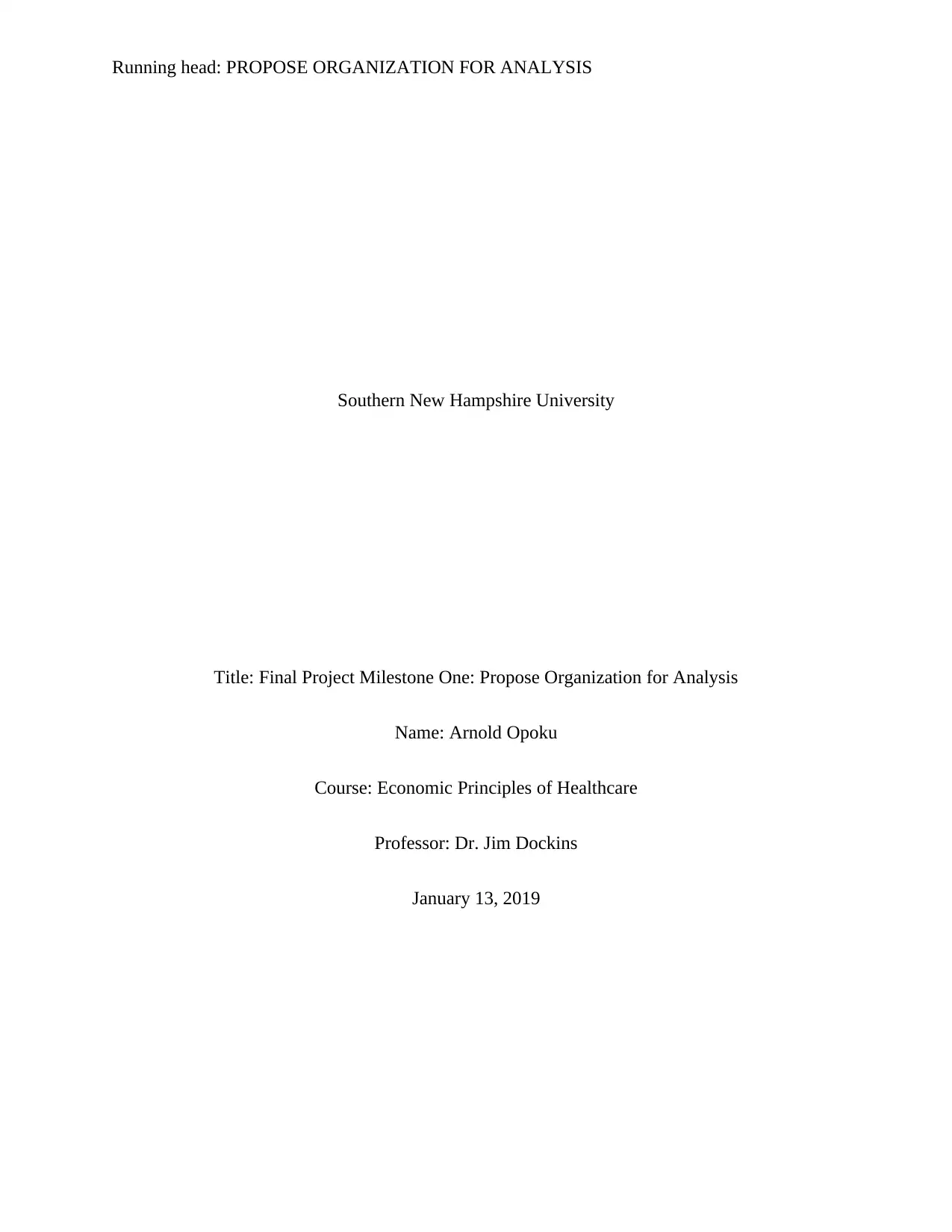
Running head: PROPOSE ORGANIZATION FOR ANALYSIS
Southern New Hampshire University
Title: Final Project Milestone One: Propose Organization for Analysis
Name: Arnold Opoku
Course: Economic Principles of Healthcare
Professor: Dr. Jim Dockins
January 13, 2019
Southern New Hampshire University
Title: Final Project Milestone One: Propose Organization for Analysis
Name: Arnold Opoku
Course: Economic Principles of Healthcare
Professor: Dr. Jim Dockins
January 13, 2019
Paraphrase This Document
Need a fresh take? Get an instant paraphrase of this document with our AI Paraphraser
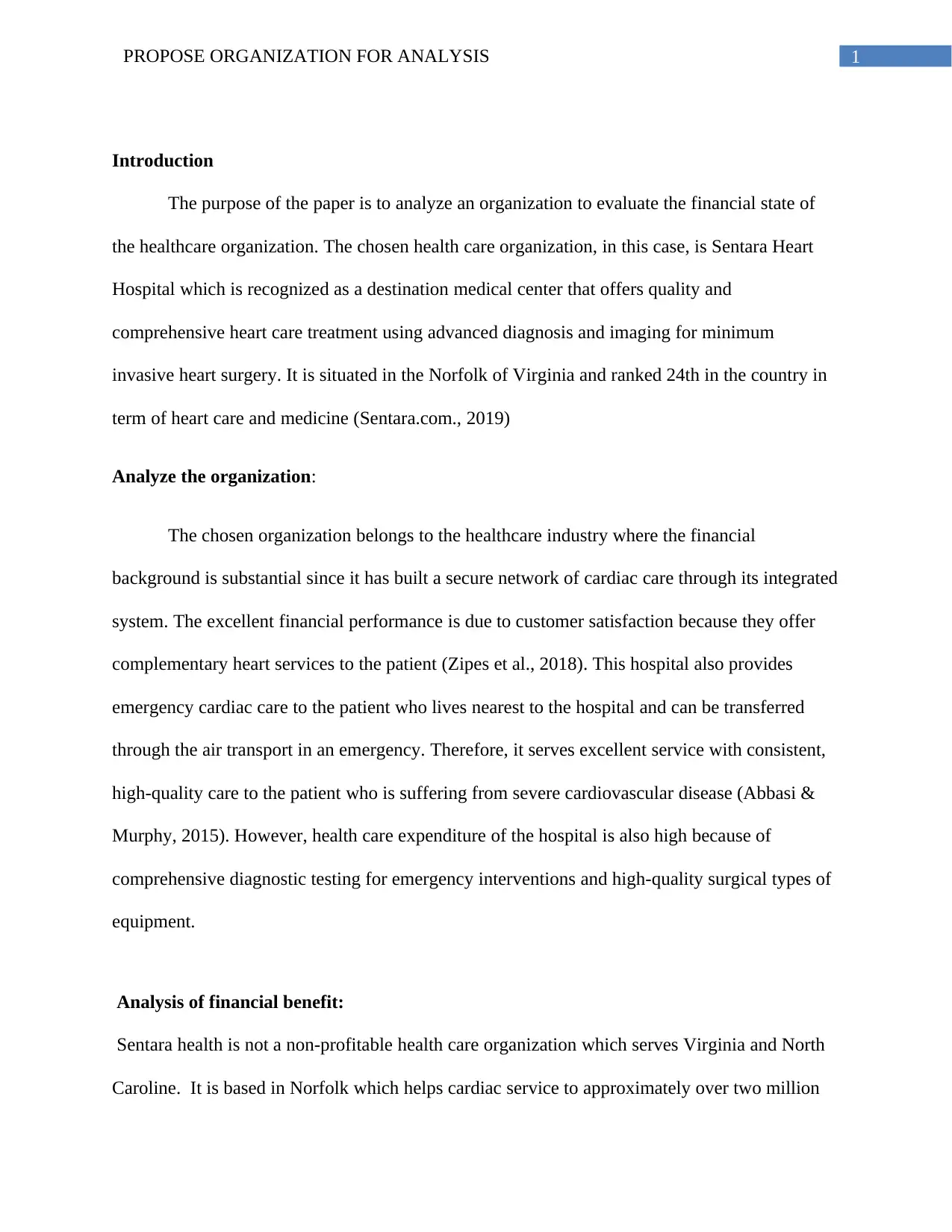
1PROPOSE ORGANIZATION FOR ANALYSIS
Introduction
The purpose of the paper is to analyze an organization to evaluate the financial state of
the healthcare organization. The chosen health care organization, in this case, is Sentara Heart
Hospital which is recognized as a destination medical center that offers quality and
comprehensive heart care treatment using advanced diagnosis and imaging for minimum
invasive heart surgery. It is situated in the Norfolk of Virginia and ranked 24th in the country in
term of heart care and medicine (Sentara.com., 2019)
Analyze the organization:
The chosen organization belongs to the healthcare industry where the financial
background is substantial since it has built a secure network of cardiac care through its integrated
system. The excellent financial performance is due to customer satisfaction because they offer
complementary heart services to the patient (Zipes et al., 2018). This hospital also provides
emergency cardiac care to the patient who lives nearest to the hospital and can be transferred
through the air transport in an emergency. Therefore, it serves excellent service with consistent,
high-quality care to the patient who is suffering from severe cardiovascular disease (Abbasi &
Murphy, 2015). However, health care expenditure of the hospital is also high because of
comprehensive diagnostic testing for emergency interventions and high-quality surgical types of
equipment.
Analysis of financial benefit:
Sentara health is not a non-profitable health care organization which serves Virginia and North
Caroline. It is based in Norfolk which helps cardiac service to approximately over two million
Introduction
The purpose of the paper is to analyze an organization to evaluate the financial state of
the healthcare organization. The chosen health care organization, in this case, is Sentara Heart
Hospital which is recognized as a destination medical center that offers quality and
comprehensive heart care treatment using advanced diagnosis and imaging for minimum
invasive heart surgery. It is situated in the Norfolk of Virginia and ranked 24th in the country in
term of heart care and medicine (Sentara.com., 2019)
Analyze the organization:
The chosen organization belongs to the healthcare industry where the financial
background is substantial since it has built a secure network of cardiac care through its integrated
system. The excellent financial performance is due to customer satisfaction because they offer
complementary heart services to the patient (Zipes et al., 2018). This hospital also provides
emergency cardiac care to the patient who lives nearest to the hospital and can be transferred
through the air transport in an emergency. Therefore, it serves excellent service with consistent,
high-quality care to the patient who is suffering from severe cardiovascular disease (Abbasi &
Murphy, 2015). However, health care expenditure of the hospital is also high because of
comprehensive diagnostic testing for emergency interventions and high-quality surgical types of
equipment.
Analysis of financial benefit:
Sentara health is not a non-profitable health care organization which serves Virginia and North
Caroline. It is based in Norfolk which helps cardiac service to approximately over two million
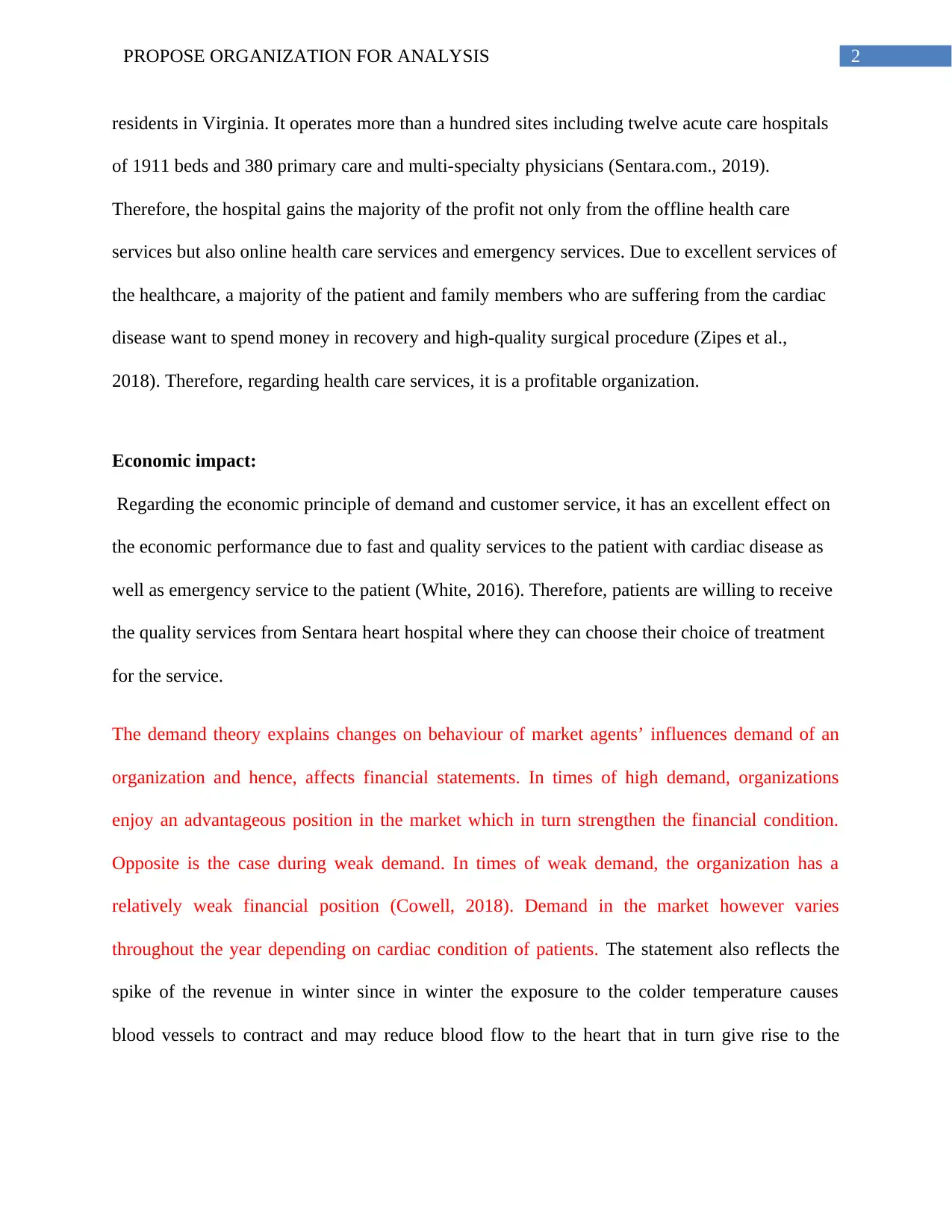
2PROPOSE ORGANIZATION FOR ANALYSIS
residents in Virginia. It operates more than a hundred sites including twelve acute care hospitals
of 1911 beds and 380 primary care and multi-specialty physicians (Sentara.com., 2019).
Therefore, the hospital gains the majority of the profit not only from the offline health care
services but also online health care services and emergency services. Due to excellent services of
the healthcare, a majority of the patient and family members who are suffering from the cardiac
disease want to spend money in recovery and high-quality surgical procedure (Zipes et al.,
2018). Therefore, regarding health care services, it is a profitable organization.
Economic impact:
Regarding the economic principle of demand and customer service, it has an excellent effect on
the economic performance due to fast and quality services to the patient with cardiac disease as
well as emergency service to the patient (White, 2016). Therefore, patients are willing to receive
the quality services from Sentara heart hospital where they can choose their choice of treatment
for the service.
The demand theory explains changes on behaviour of market agents’ influences demand of an
organization and hence, affects financial statements. In times of high demand, organizations
enjoy an advantageous position in the market which in turn strengthen the financial condition.
Opposite is the case during weak demand. In times of weak demand, the organization has a
relatively weak financial position (Cowell, 2018). Demand in the market however varies
throughout the year depending on cardiac condition of patients. The statement also reflects the
spike of the revenue in winter since in winter the exposure to the colder temperature causes
blood vessels to contract and may reduce blood flow to the heart that in turn give rise to the
residents in Virginia. It operates more than a hundred sites including twelve acute care hospitals
of 1911 beds and 380 primary care and multi-specialty physicians (Sentara.com., 2019).
Therefore, the hospital gains the majority of the profit not only from the offline health care
services but also online health care services and emergency services. Due to excellent services of
the healthcare, a majority of the patient and family members who are suffering from the cardiac
disease want to spend money in recovery and high-quality surgical procedure (Zipes et al.,
2018). Therefore, regarding health care services, it is a profitable organization.
Economic impact:
Regarding the economic principle of demand and customer service, it has an excellent effect on
the economic performance due to fast and quality services to the patient with cardiac disease as
well as emergency service to the patient (White, 2016). Therefore, patients are willing to receive
the quality services from Sentara heart hospital where they can choose their choice of treatment
for the service.
The demand theory explains changes on behaviour of market agents’ influences demand of an
organization and hence, affects financial statements. In times of high demand, organizations
enjoy an advantageous position in the market which in turn strengthen the financial condition.
Opposite is the case during weak demand. In times of weak demand, the organization has a
relatively weak financial position (Cowell, 2018). Demand in the market however varies
throughout the year depending on cardiac condition of patients. The statement also reflects the
spike of the revenue in winter since in winter the exposure to the colder temperature causes
blood vessels to contract and may reduce blood flow to the heart that in turn give rise to the
⊘ This is a preview!⊘
Do you want full access?
Subscribe today to unlock all pages.

Trusted by 1+ million students worldwide
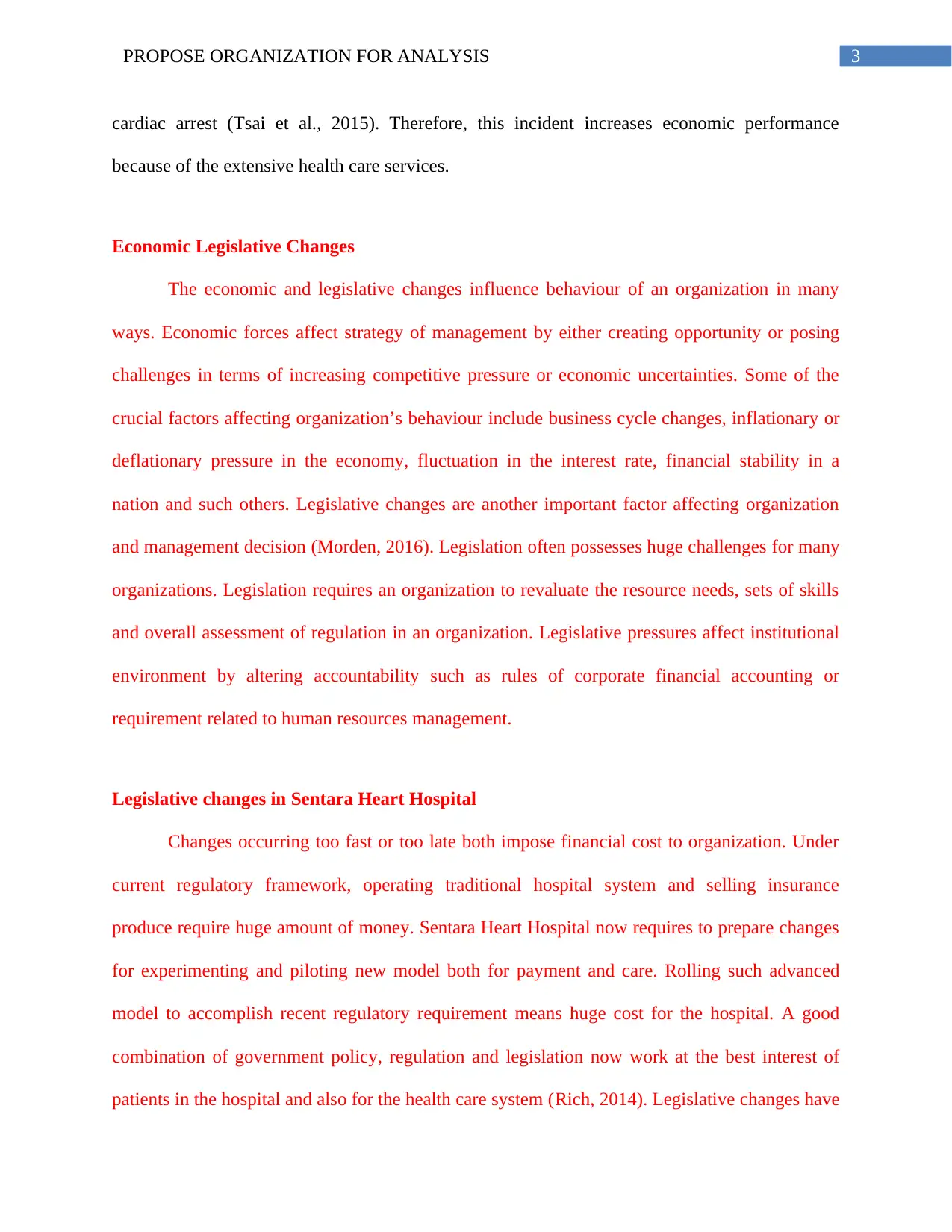
3PROPOSE ORGANIZATION FOR ANALYSIS
cardiac arrest (Tsai et al., 2015). Therefore, this incident increases economic performance
because of the extensive health care services.
Economic Legislative Changes
The economic and legislative changes influence behaviour of an organization in many
ways. Economic forces affect strategy of management by either creating opportunity or posing
challenges in terms of increasing competitive pressure or economic uncertainties. Some of the
crucial factors affecting organization’s behaviour include business cycle changes, inflationary or
deflationary pressure in the economy, fluctuation in the interest rate, financial stability in a
nation and such others. Legislative changes are another important factor affecting organization
and management decision (Morden, 2016). Legislation often possesses huge challenges for many
organizations. Legislation requires an organization to revaluate the resource needs, sets of skills
and overall assessment of regulation in an organization. Legislative pressures affect institutional
environment by altering accountability such as rules of corporate financial accounting or
requirement related to human resources management.
Legislative changes in Sentara Heart Hospital
Changes occurring too fast or too late both impose financial cost to organization. Under
current regulatory framework, operating traditional hospital system and selling insurance
produce require huge amount of money. Sentara Heart Hospital now requires to prepare changes
for experimenting and piloting new model both for payment and care. Rolling such advanced
model to accomplish recent regulatory requirement means huge cost for the hospital. A good
combination of government policy, regulation and legislation now work at the best interest of
patients in the hospital and also for the health care system (Rich, 2014). Legislative changes have
cardiac arrest (Tsai et al., 2015). Therefore, this incident increases economic performance
because of the extensive health care services.
Economic Legislative Changes
The economic and legislative changes influence behaviour of an organization in many
ways. Economic forces affect strategy of management by either creating opportunity or posing
challenges in terms of increasing competitive pressure or economic uncertainties. Some of the
crucial factors affecting organization’s behaviour include business cycle changes, inflationary or
deflationary pressure in the economy, fluctuation in the interest rate, financial stability in a
nation and such others. Legislative changes are another important factor affecting organization
and management decision (Morden, 2016). Legislation often possesses huge challenges for many
organizations. Legislation requires an organization to revaluate the resource needs, sets of skills
and overall assessment of regulation in an organization. Legislative pressures affect institutional
environment by altering accountability such as rules of corporate financial accounting or
requirement related to human resources management.
Legislative changes in Sentara Heart Hospital
Changes occurring too fast or too late both impose financial cost to organization. Under
current regulatory framework, operating traditional hospital system and selling insurance
produce require huge amount of money. Sentara Heart Hospital now requires to prepare changes
for experimenting and piloting new model both for payment and care. Rolling such advanced
model to accomplish recent regulatory requirement means huge cost for the hospital. A good
combination of government policy, regulation and legislation now work at the best interest of
patients in the hospital and also for the health care system (Rich, 2014). Legislative changes have
Paraphrase This Document
Need a fresh take? Get an instant paraphrase of this document with our AI Paraphraser
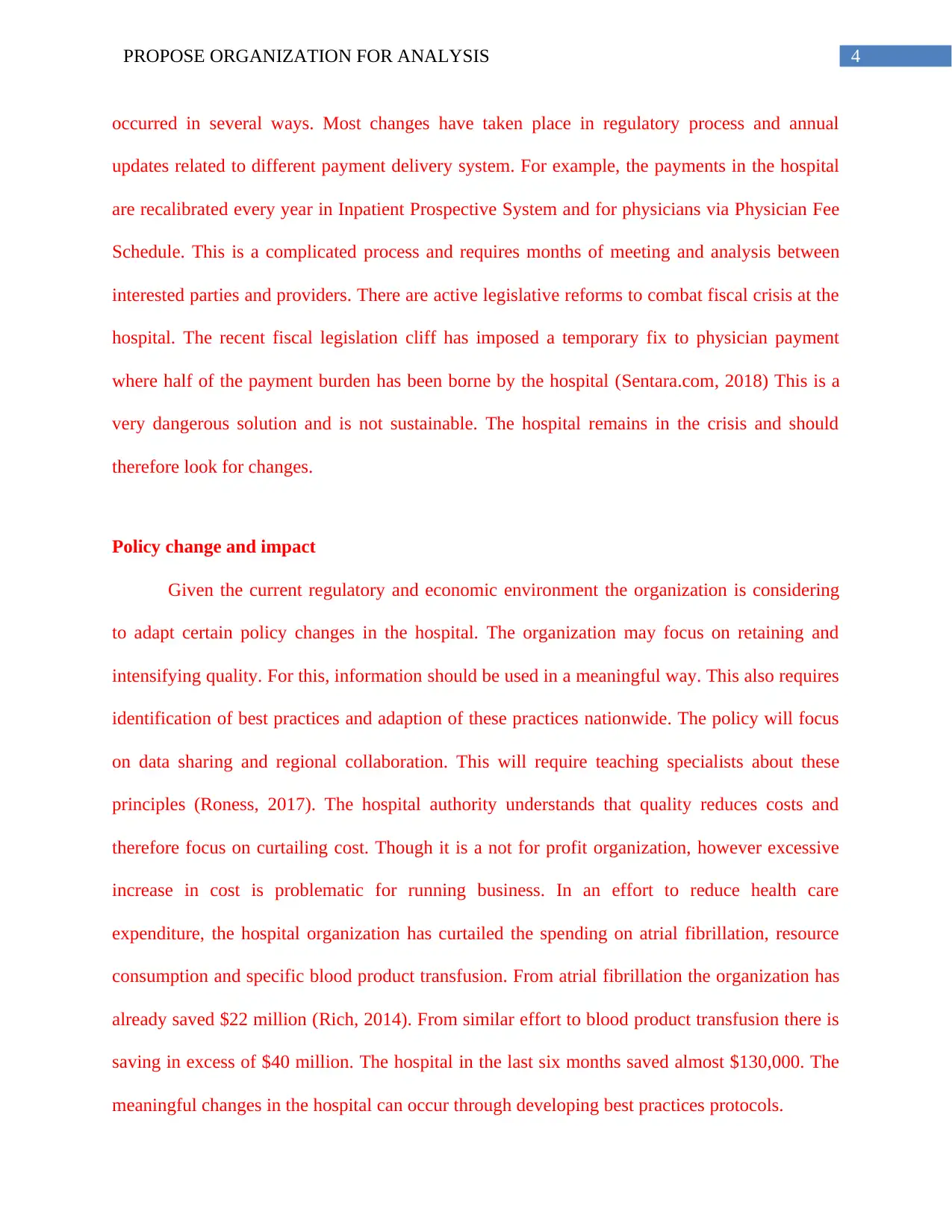
4PROPOSE ORGANIZATION FOR ANALYSIS
occurred in several ways. Most changes have taken place in regulatory process and annual
updates related to different payment delivery system. For example, the payments in the hospital
are recalibrated every year in Inpatient Prospective System and for physicians via Physician Fee
Schedule. This is a complicated process and requires months of meeting and analysis between
interested parties and providers. There are active legislative reforms to combat fiscal crisis at the
hospital. The recent fiscal legislation cliff has imposed a temporary fix to physician payment
where half of the payment burden has been borne by the hospital (Sentara.com, 2018) This is a
very dangerous solution and is not sustainable. The hospital remains in the crisis and should
therefore look for changes.
Policy change and impact
Given the current regulatory and economic environment the organization is considering
to adapt certain policy changes in the hospital. The organization may focus on retaining and
intensifying quality. For this, information should be used in a meaningful way. This also requires
identification of best practices and adaption of these practices nationwide. The policy will focus
on data sharing and regional collaboration. This will require teaching specialists about these
principles (Roness, 2017). The hospital authority understands that quality reduces costs and
therefore focus on curtailing cost. Though it is a not for profit organization, however excessive
increase in cost is problematic for running business. In an effort to reduce health care
expenditure, the hospital organization has curtailed the spending on atrial fibrillation, resource
consumption and specific blood product transfusion. From atrial fibrillation the organization has
already saved $22 million (Rich, 2014). From similar effort to blood product transfusion there is
saving in excess of $40 million. The hospital in the last six months saved almost $130,000. The
meaningful changes in the hospital can occur through developing best practices protocols.
occurred in several ways. Most changes have taken place in regulatory process and annual
updates related to different payment delivery system. For example, the payments in the hospital
are recalibrated every year in Inpatient Prospective System and for physicians via Physician Fee
Schedule. This is a complicated process and requires months of meeting and analysis between
interested parties and providers. There are active legislative reforms to combat fiscal crisis at the
hospital. The recent fiscal legislation cliff has imposed a temporary fix to physician payment
where half of the payment burden has been borne by the hospital (Sentara.com, 2018) This is a
very dangerous solution and is not sustainable. The hospital remains in the crisis and should
therefore look for changes.
Policy change and impact
Given the current regulatory and economic environment the organization is considering
to adapt certain policy changes in the hospital. The organization may focus on retaining and
intensifying quality. For this, information should be used in a meaningful way. This also requires
identification of best practices and adaption of these practices nationwide. The policy will focus
on data sharing and regional collaboration. This will require teaching specialists about these
principles (Roness, 2017). The hospital authority understands that quality reduces costs and
therefore focus on curtailing cost. Though it is a not for profit organization, however excessive
increase in cost is problematic for running business. In an effort to reduce health care
expenditure, the hospital organization has curtailed the spending on atrial fibrillation, resource
consumption and specific blood product transfusion. From atrial fibrillation the organization has
already saved $22 million (Rich, 2014). From similar effort to blood product transfusion there is
saving in excess of $40 million. The hospital in the last six months saved almost $130,000. The
meaningful changes in the hospital can occur through developing best practices protocols.
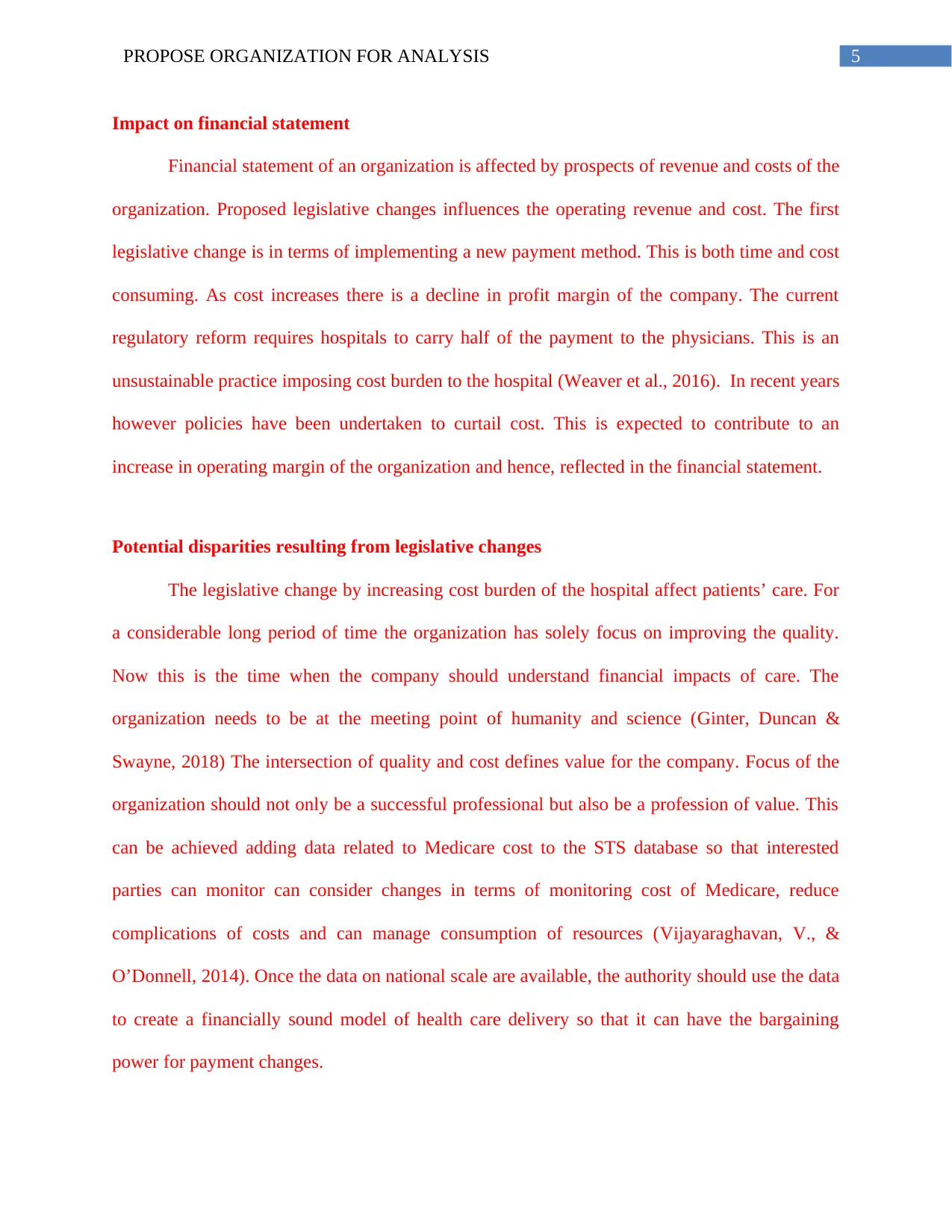
5PROPOSE ORGANIZATION FOR ANALYSIS
Impact on financial statement
Financial statement of an organization is affected by prospects of revenue and costs of the
organization. Proposed legislative changes influences the operating revenue and cost. The first
legislative change is in terms of implementing a new payment method. This is both time and cost
consuming. As cost increases there is a decline in profit margin of the company. The current
regulatory reform requires hospitals to carry half of the payment to the physicians. This is an
unsustainable practice imposing cost burden to the hospital (Weaver et al., 2016). In recent years
however policies have been undertaken to curtail cost. This is expected to contribute to an
increase in operating margin of the organization and hence, reflected in the financial statement.
Potential disparities resulting from legislative changes
The legislative change by increasing cost burden of the hospital affect patients’ care. For
a considerable long period of time the organization has solely focus on improving the quality.
Now this is the time when the company should understand financial impacts of care. The
organization needs to be at the meeting point of humanity and science (Ginter, Duncan &
Swayne, 2018) The intersection of quality and cost defines value for the company. Focus of the
organization should not only be a successful professional but also be a profession of value. This
can be achieved adding data related to Medicare cost to the STS database so that interested
parties can monitor can consider changes in terms of monitoring cost of Medicare, reduce
complications of costs and can manage consumption of resources (Vijayaraghavan, V., &
O’Donnell, 2014). Once the data on national scale are available, the authority should use the data
to create a financially sound model of health care delivery so that it can have the bargaining
power for payment changes.
Impact on financial statement
Financial statement of an organization is affected by prospects of revenue and costs of the
organization. Proposed legislative changes influences the operating revenue and cost. The first
legislative change is in terms of implementing a new payment method. This is both time and cost
consuming. As cost increases there is a decline in profit margin of the company. The current
regulatory reform requires hospitals to carry half of the payment to the physicians. This is an
unsustainable practice imposing cost burden to the hospital (Weaver et al., 2016). In recent years
however policies have been undertaken to curtail cost. This is expected to contribute to an
increase in operating margin of the organization and hence, reflected in the financial statement.
Potential disparities resulting from legislative changes
The legislative change by increasing cost burden of the hospital affect patients’ care. For
a considerable long period of time the organization has solely focus on improving the quality.
Now this is the time when the company should understand financial impacts of care. The
organization needs to be at the meeting point of humanity and science (Ginter, Duncan &
Swayne, 2018) The intersection of quality and cost defines value for the company. Focus of the
organization should not only be a successful professional but also be a profession of value. This
can be achieved adding data related to Medicare cost to the STS database so that interested
parties can monitor can consider changes in terms of monitoring cost of Medicare, reduce
complications of costs and can manage consumption of resources (Vijayaraghavan, V., &
O’Donnell, 2014). Once the data on national scale are available, the authority should use the data
to create a financially sound model of health care delivery so that it can have the bargaining
power for payment changes.
⊘ This is a preview!⊘
Do you want full access?
Subscribe today to unlock all pages.

Trusted by 1+ million students worldwide
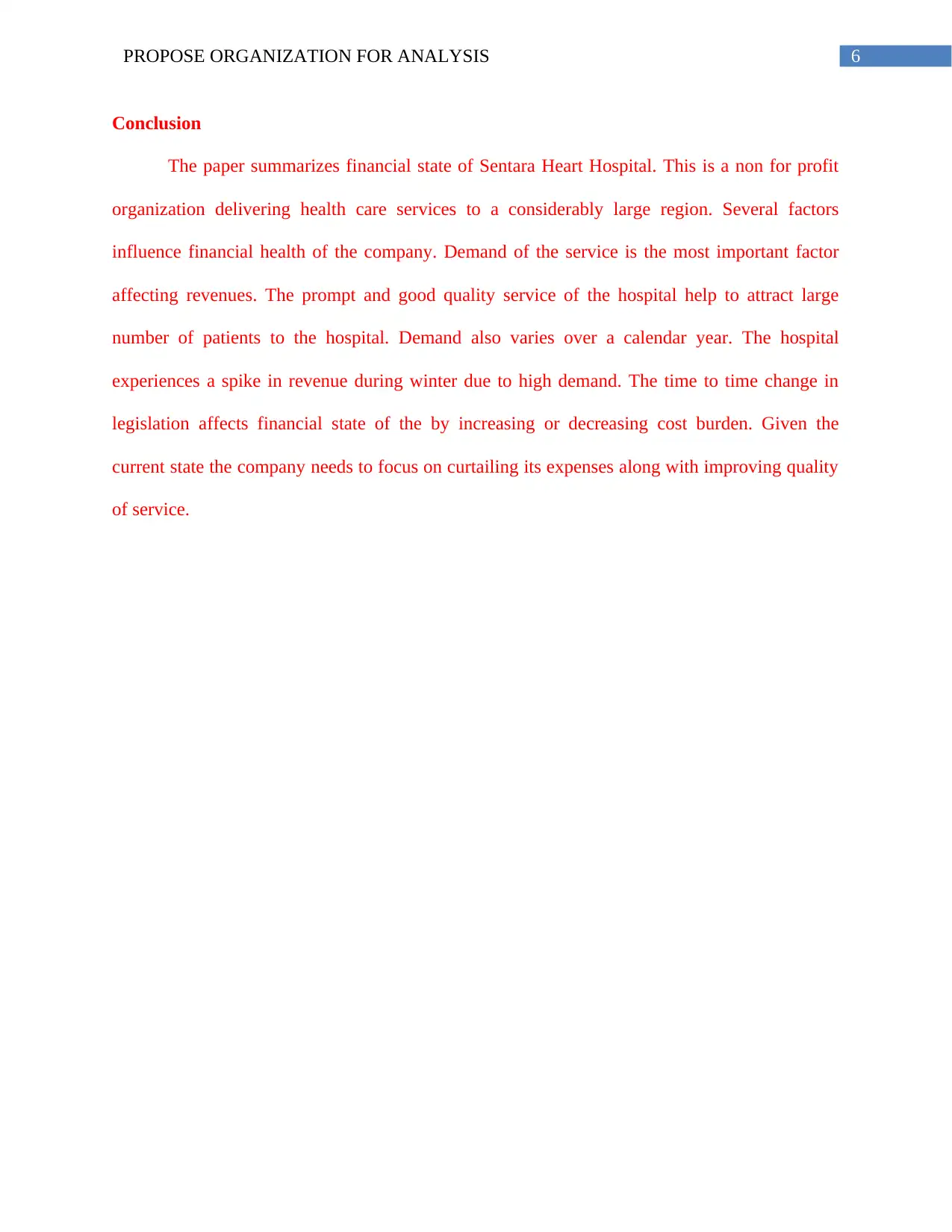
6PROPOSE ORGANIZATION FOR ANALYSIS
Conclusion
The paper summarizes financial state of Sentara Heart Hospital. This is a non for profit
organization delivering health care services to a considerably large region. Several factors
influence financial health of the company. Demand of the service is the most important factor
affecting revenues. The prompt and good quality service of the hospital help to attract large
number of patients to the hospital. Demand also varies over a calendar year. The hospital
experiences a spike in revenue during winter due to high demand. The time to time change in
legislation affects financial state of the by increasing or decreasing cost burden. Given the
current state the company needs to focus on curtailing its expenses along with improving quality
of service.
Conclusion
The paper summarizes financial state of Sentara Heart Hospital. This is a non for profit
organization delivering health care services to a considerably large region. Several factors
influence financial health of the company. Demand of the service is the most important factor
affecting revenues. The prompt and good quality service of the hospital help to attract large
number of patients to the hospital. Demand also varies over a calendar year. The hospital
experiences a spike in revenue during winter due to high demand. The time to time change in
legislation affects financial state of the by increasing or decreasing cost burden. Given the
current state the company needs to focus on curtailing its expenses along with improving quality
of service.
Paraphrase This Document
Need a fresh take? Get an instant paraphrase of this document with our AI Paraphraser
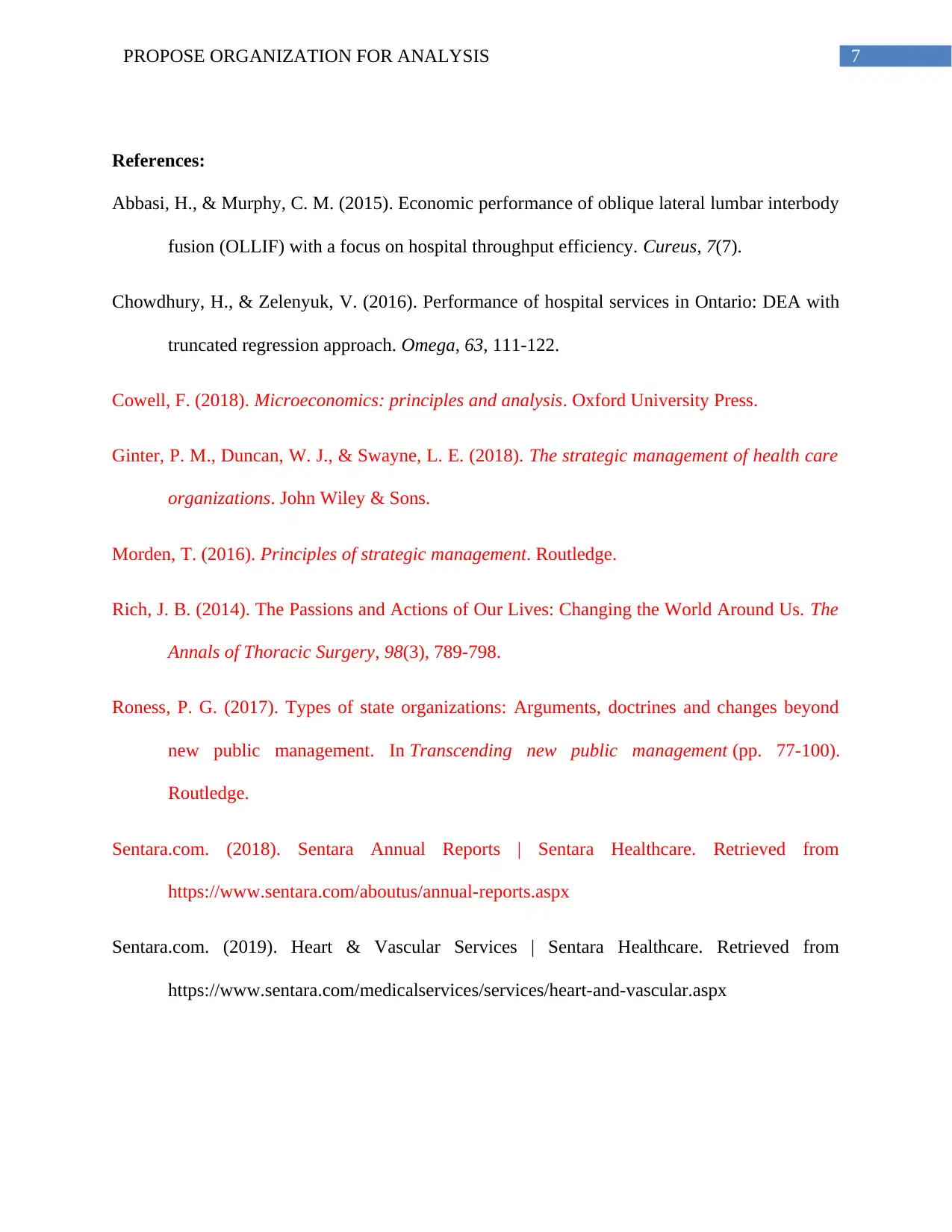
7PROPOSE ORGANIZATION FOR ANALYSIS
References:
Abbasi, H., & Murphy, C. M. (2015). Economic performance of oblique lateral lumbar interbody
fusion (OLLIF) with a focus on hospital throughput efficiency. Cureus, 7(7).
Chowdhury, H., & Zelenyuk, V. (2016). Performance of hospital services in Ontario: DEA with
truncated regression approach. Omega, 63, 111-122.
Cowell, F. (2018). Microeconomics: principles and analysis. Oxford University Press.
Ginter, P. M., Duncan, W. J., & Swayne, L. E. (2018). The strategic management of health care
organizations. John Wiley & Sons.
Morden, T. (2016). Principles of strategic management. Routledge.
Rich, J. B. (2014). The Passions and Actions of Our Lives: Changing the World Around Us. The
Annals of Thoracic Surgery, 98(3), 789-798.
Roness, P. G. (2017). Types of state organizations: Arguments, doctrines and changes beyond
new public management. In Transcending new public management (pp. 77-100).
Routledge.
Sentara.com. (2018). Sentara Annual Reports | Sentara Healthcare. Retrieved from
https://www.sentara.com/aboutus/annual-reports.aspx
Sentara.com. (2019). Heart & Vascular Services | Sentara Healthcare. Retrieved from
https://www.sentara.com/medicalservices/services/heart-and-vascular.aspx
References:
Abbasi, H., & Murphy, C. M. (2015). Economic performance of oblique lateral lumbar interbody
fusion (OLLIF) with a focus on hospital throughput efficiency. Cureus, 7(7).
Chowdhury, H., & Zelenyuk, V. (2016). Performance of hospital services in Ontario: DEA with
truncated regression approach. Omega, 63, 111-122.
Cowell, F. (2018). Microeconomics: principles and analysis. Oxford University Press.
Ginter, P. M., Duncan, W. J., & Swayne, L. E. (2018). The strategic management of health care
organizations. John Wiley & Sons.
Morden, T. (2016). Principles of strategic management. Routledge.
Rich, J. B. (2014). The Passions and Actions of Our Lives: Changing the World Around Us. The
Annals of Thoracic Surgery, 98(3), 789-798.
Roness, P. G. (2017). Types of state organizations: Arguments, doctrines and changes beyond
new public management. In Transcending new public management (pp. 77-100).
Routledge.
Sentara.com. (2018). Sentara Annual Reports | Sentara Healthcare. Retrieved from
https://www.sentara.com/aboutus/annual-reports.aspx
Sentara.com. (2019). Heart & Vascular Services | Sentara Healthcare. Retrieved from
https://www.sentara.com/medicalservices/services/heart-and-vascular.aspx
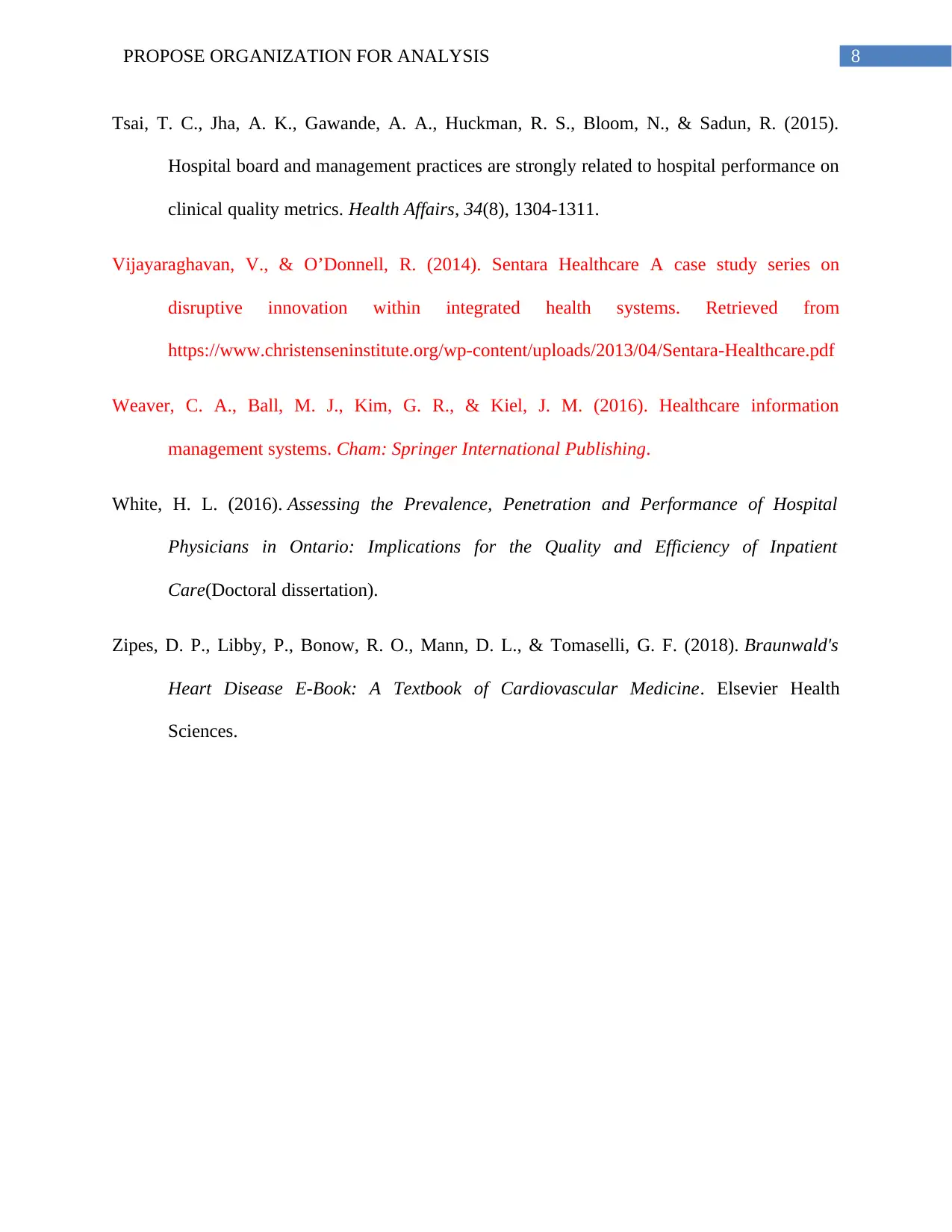
8PROPOSE ORGANIZATION FOR ANALYSIS
Tsai, T. C., Jha, A. K., Gawande, A. A., Huckman, R. S., Bloom, N., & Sadun, R. (2015).
Hospital board and management practices are strongly related to hospital performance on
clinical quality metrics. Health Affairs, 34(8), 1304-1311.
Vijayaraghavan, V., & O’Donnell, R. (2014). Sentara Healthcare A case study series on
disruptive innovation within integrated health systems. Retrieved from
https://www.christenseninstitute.org/wp-content/uploads/2013/04/Sentara-Healthcare.pdf
Weaver, C. A., Ball, M. J., Kim, G. R., & Kiel, J. M. (2016). Healthcare information
management systems. Cham: Springer International Publishing.
White, H. L. (2016). Assessing the Prevalence, Penetration and Performance of Hospital
Physicians in Ontario: Implications for the Quality and Efficiency of Inpatient
Care(Doctoral dissertation).
Zipes, D. P., Libby, P., Bonow, R. O., Mann, D. L., & Tomaselli, G. F. (2018). Braunwald's
Heart Disease E-Book: A Textbook of Cardiovascular Medicine. Elsevier Health
Sciences.
Tsai, T. C., Jha, A. K., Gawande, A. A., Huckman, R. S., Bloom, N., & Sadun, R. (2015).
Hospital board and management practices are strongly related to hospital performance on
clinical quality metrics. Health Affairs, 34(8), 1304-1311.
Vijayaraghavan, V., & O’Donnell, R. (2014). Sentara Healthcare A case study series on
disruptive innovation within integrated health systems. Retrieved from
https://www.christenseninstitute.org/wp-content/uploads/2013/04/Sentara-Healthcare.pdf
Weaver, C. A., Ball, M. J., Kim, G. R., & Kiel, J. M. (2016). Healthcare information
management systems. Cham: Springer International Publishing.
White, H. L. (2016). Assessing the Prevalence, Penetration and Performance of Hospital
Physicians in Ontario: Implications for the Quality and Efficiency of Inpatient
Care(Doctoral dissertation).
Zipes, D. P., Libby, P., Bonow, R. O., Mann, D. L., & Tomaselli, G. F. (2018). Braunwald's
Heart Disease E-Book: A Textbook of Cardiovascular Medicine. Elsevier Health
Sciences.
⊘ This is a preview!⊘
Do you want full access?
Subscribe today to unlock all pages.

Trusted by 1+ million students worldwide
1 out of 9
Related Documents
Your All-in-One AI-Powered Toolkit for Academic Success.
+13062052269
info@desklib.com
Available 24*7 on WhatsApp / Email
![[object Object]](/_next/static/media/star-bottom.7253800d.svg)
Unlock your academic potential
Copyright © 2020–2025 A2Z Services. All Rights Reserved. Developed and managed by ZUCOL.





